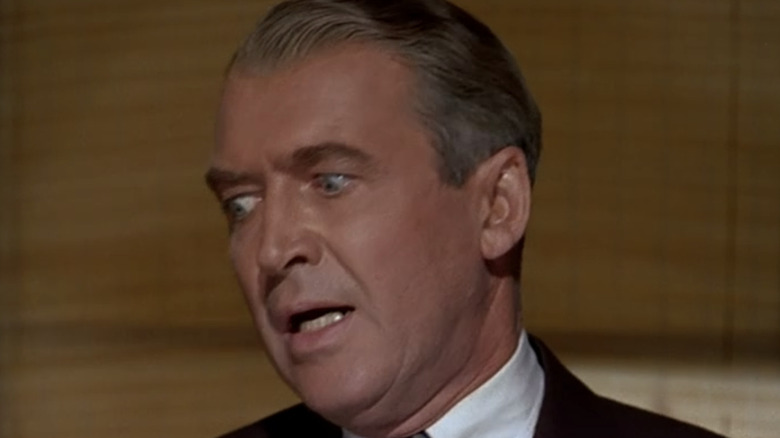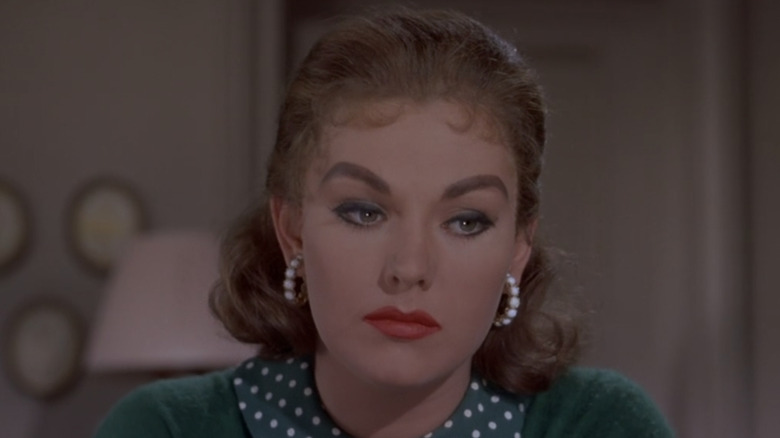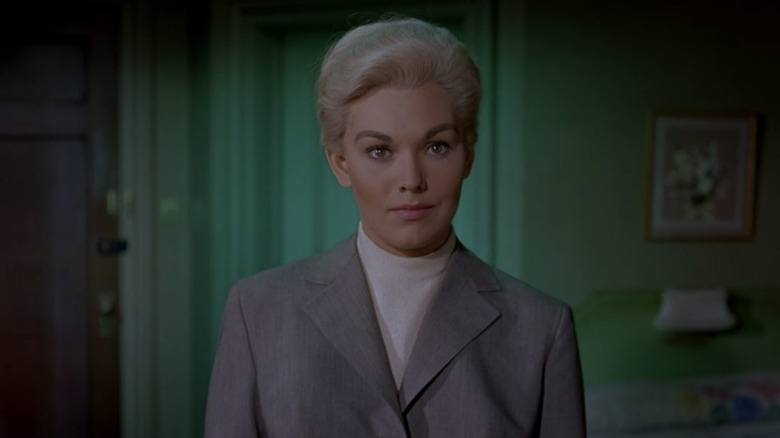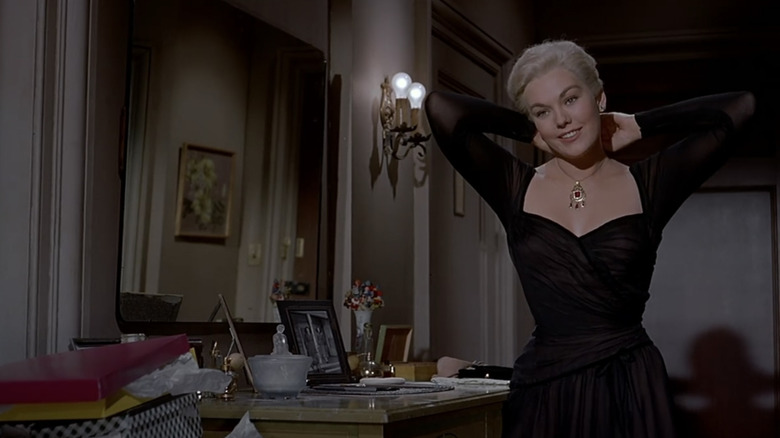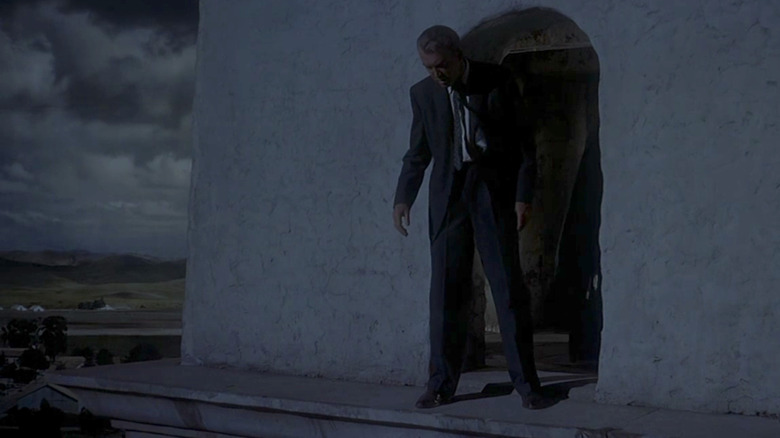The Ending Of Vertigo Explained
When Alfred Hitchcock's "Vertigo" was first released in 1958, critics and audiences alike thought it fell short of the famed director's abilities, and the film barely broke even. But it has since been recognized for its top-tier acting, story, and cinematography, even becoming one of the few movies to earn a perfect Metacritic rating.
The film begins with policeman John "Scottie" Ferguson (James Stewart) and another officer in hot pursuit of a criminal on the rooftops of San Francisco. When Scottie's leap onto a roof falls a bit short, leaving him precariously dangling from the roof's gutter over a multi-story drop, his partner attempts to save him but loses his balance and plummets to his death. Though Scottie survives, he retires from the force, his newfound acrophobia (fear of heights) and vertigo (the feeling that one's surroundings are moving or spinning when they are not) too debilitating for him to continue his work.
Now jobless, Scottie looks toward an uncertain future, but an old acquaintance, Gavin Elster (Tom Helmore), soon contacts him with a less demanding assignment: to follow his wife, Madeleine (Kim Novak), who has begun to act very strangely. Working as a private investigator, Scottie comes to believe that Madeleine is possessed by her great-grandmother, Carlotta Valdes, the mistress of a wealthy man who ultimately kept their child but abandoned her, leading her to die by suicide. Now it seems Madeleine may be on the path to taking her own life.
Perhaps in part because the circumstances of this assignment are so strange, Scottie becomes obsessed with Madeleine, and the two fall in love — before Madeleine jumps from the bell tower at Mission San Juan Bautista. This happens about one hour and 20 minutes into "Vertigo," making it seem like the film's end, but with almost an hour left in the film, there's plenty of time for things to get much more complex.
The aftermath of Madeleine's death
A court rules Madeleine's death a suicide, and Scottie, who feels responsible for her demise, winds up in a sanitarium, where he is treated for "acute melancholia" — 1950s speak for clinical depression — and "a guilt complex." He is eventually released from the sanitarium but remains deeply affected. Still infatuated with Madeleine, Scottie frequently returns to the places where he used to follow the possessed possessor of his heart, his obsession growing until one day he spots a young woman who, despite her brunette hair and different style, resembles his lost love.
Scottie follows the woman into the Empire Hotel and knocks on her door, but when the two start talking, it's clear that this is not Madeleine. The woman — named Judy Barton — has a coarser demeanor, a different accent, and (most importantly) wants nothing to do with the retired police detective. But Scottie is persistent and ultimately convinces her to let him in, where he asks all about her life, gobsmacked that this splitting image of Madeleine has her own backstory — she at one point even has to get her old Kansas driver's license out to make him believe her.
Despite his coming off as a major creep, Judy agrees to go to dinner with Scottie, and when he leaves her hotel room, the audience learns why. Judy flashes back to that fateful night at the mission, where she, as Madeleine, runs up the stairs of the bell tower to find Gavin with the real Madeleine, already dead, in his arms, waiting to throw her onto the roof below. Not only was Scottie right to see Madeleine in Judy, he's also in love with a character, an imitation — and an accessory to murder!
A forced makeover
Judy almost skips town, leaving a letter behind for Scottie detailing the murder plot, but she decides she has "the nerve to try" to hide her past manipulation of him, rips up the letter, and starts getting ready for their date. After a few outings together, Scottie works up some nerve of his own and decides he'll transform Judy into the Madeleine he so misses. He buys her the same gray suit that Madeleine wore, the same shoes, her same black evening gown — he even gets her makeup, nails, and hair redone all to look like Madeleine.
When Judy returns to the hotel from her day at the salon, Scottie is upset that she hasn't put her now-blond hair up in a bun a la Madeleine. But he eventually convinces her to restyle it, even though she doesn't like the look. Once Judy is totally transformed, Scottie is overtaken with passion and the two kiss. As the camera revolves around their embrace, the background changes from Judy's hotel room to the bell tower at Mission San Juan Bautista, implying a necrophilic side to his affection — if it wasn't clear by now, his obsession is a dark one.
For a bit, things settle into a nice rhythm for the couple, but it all comes to a halt one night when Judy matches Madeleine a little too closely.
Like the spinning sensation of vertigo, the film's events come full circle
When Judy wears a necklace that Scottie recognizes from Madeleine's jewelry collection — this piece in particular having belonged to Carlotta Valdes — he begins to put the pieces together, deciding that he must take Judy to the mission to relive the traumatic experience he had there in order to overcome it. This is a concept that his ex-fiancée turned best friend Midge had introduced to him early on in the film.
Scottie forces Judy to climb the stairs of the bell tower, wrestling her as he takes her through, step by step, the crime she has helped commit. When they reach the bell chamber, Judy reveals that the wrench in her and Gavin's plans was that she fell in love with Scottie; the two then embrace. As Judy begs for Scottie to recognize the love they still have for each other, he says, "It's too late, there's no bringing her back" — he fell in love with the character Madeleine, not the actress Judy. But then, in a confused moment that perfectly matches the strange combination of fear and love in the scene, the two kiss. A nun appears from the shadows, having heard their voices, and Judy, startled, steps backward in fear — and out one of the openings of the belfry, falling to her death.
Coincidence or copycat crime?
Stepping out onto the ledge to look down at Judy's body, Scottie has clearly overcome his acrophobia. While his obsession with Madeleine/Judy has overshadowed his fears, however, this same obsession might also have clouded his perception of reality. Judy's death scene is a bit questionable. She hears footsteps, glances at the nun, then pauses, finally rushing away from Scottie and going over the edge of the tower. These seven seconds feel way too long to be a deadly reaction to some jump scare, as the audience is encouraged to believe.
Is it possible that Scottie had pushed Judy, and the audience is just being shown his self-exonerating explanation of the events leading up to her death? He was being pretty violent with her on the tower's steps, and his last words to her include the somewhat threatening phrase, "It's too late." Why would he have brought her up there in the first place, if not to exact some sort of cruel revenge on her? We'll never know for sure. The film ends with Scottie standing on that ledge, looking down at the dead Judy — unlike with Madeleine's death, no trial follows for the audience to see. But the dubious circumstances of Judy's death ultimately make "Vertigo" even more captivating of a story, ensuring it remains a fan-favorite Hitchcock flick for decades to come.
